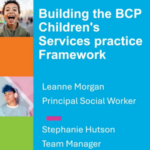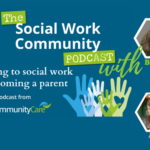
By Brid Featherstone and Kate Morris
We have been involved in a research project for over two years now the state of knowledge about domestic violence and abuse (DVA) in child protection (Rethinking domestic abuse in child protection: responding differently – Nuffield Foundation). Our research in three case-study sites has interrogated:
- The data that is gathered about prevalence and dimensions of the problem.
- Manager and practitioner understandings of causation, typologies and alternative modes of response.
- How intersecting inequalities shape experiences and responses.
- Family members’ understandings and perspectives on professional responses.
Debate over coercive control training
We were, therefore, very interested in the findings from the recent study by the BBC highlighting the lack of specific training on coercive control on more than a third of social work courses and the large variations in content on the remainder.
According to the authors, this lack of training was of particular concern as coercive and controlling behaviour is recognised as underpinning all domestic abuse. The BBC research led the Domestic Abuse Commissioner to call for such training to be made mandatory
In response, a spokesperson for the Joint Universities Social Work Association (JUSWA) argued that initial education does not claim or have a remit to prepare newly qualified social workers to be “thrown into the deep end” of what should be regarded as highly specialised practice.
We welcome the opening up of conversations about the training and role of social workers but worry that both ‘sides’ are in danger of making assumptions about the robustness of the current knowledge base and, in turn, what service responses should be.
Findings from child protection and domestic abuse research
We offer the following findings from our research not only as a contribution to troubling such assumptions, but hopefully to help promote further discussion:
- We found that we are simply not collecting the kind of data that helps us understand what is going on in families’ lives in relation to domestic violence and abuse. This means that statements about prevalence must be treated with caution and there is an urgent need for the Department for Education to pay attention to how best to capture robust data in order to inform commissioning and services. For example, the current categories, being used in the children in need census do not provide the data needed for effective responses. Moreover, practitioners are not being supported to understand why collecting robust data matters and why it might improve practice responses.
- Crucially, the data being collected cannot help us to understand the impact of intersecting gender inequalities. Furthermore, the international literature on intersectionality is not well known in practice. Therefore, the risks and vulnerabilities attached to those living in poverty, from differing minority ethnic groups, abilities, ages and sexualities are not being fully addressed.
- While there are pockets of excellent practice in this regard, overall, there is little knowledge about the literature that explores the differences between types of abuse and violence and consequent risks. Moreover, practitioners are not being supported to have empirically grounded conversations about ‘what’ and ‘why’ with all those impacted. This results from, and contributes to, practice cultures dominated by reductive terms such as, ‘there is dv in that family’, or, ‘coercive control is present’. This use of non-specific generic descriptors feeds a generalised sense of fear and impotence among practitioners and means the lived realities of those impacted are rarely captured.
- Individualised case work is being relied upon to tackle what is generally recognised as, including by all involved in the research, a problem that needs action at multiple levels across society.
- Multi-agency working is the routine response to calls for service improvement, but we found limited evidence of multi-agency working that utilised the expertise of family members and communities. Given that many respondents were concerned about levels of distrust among families and communities towards services, this reliance on multi-agency working seemed rather curious and concerning, especially given the well-documented issues for minoritised communities.
The challenges of doing things differently
It is important to note that we found many attempts to ‘think and do differently’ in relation to domestic abuse and a number are offered here to highlight some of the challenges that emerged that need to be acknowledged if change is to become a widespread reality.
One area had developed a very well-evidenced and robust specialist service, which engaged with the literature on different types of abuse, developed responsive approaches to the women, children and men concerned and was doing groundbreaking work on community engagement. However, this was not becoming embedded in frontline practice despite recognition of the need to do so. The lack of time to build meaningful trusting relationships was cited as a key barrier here, as was workforce instability and churn in a landscape dominated by the impact of austerity on an impoverished local authority.
Another area had sought to involve family members and move away from more punitive formal interventions focused on mothering. However, the constraints of addressing a complex social problem within the confines of a narrow risk-focused child protection system curtailed imaginative and holistic approaches, especially in relation to working with men.
The limits of individual casework
Overall, we found that, despite sterling attempts by amazing practitioners and managers, they were often trapped within approaches that relied on individual casework and risk management. This, in turn, translated into the outsourcing of safety and protection responsibilities to those most vulnerable and least able to respond (often impoverished mothers).
Daring to ‘think and do differently’ in child protection in relation to domestic abuse requires the opening up of conversations about the status of our knowledge and the expansion of who gets to contribute to those conversations.
The training of social workers is very important as part of such endeavours, but it is part of a bigger story that must involve multiple storytellers, with all those who are impacted at its heart.
Brid Featherstone is emeritus professor of social work at the University of Huddersfield and Kate Morris is professor of social work at Sheffield University. You can find out more about Brid’s work by reading our interview with her for Community Care’s 50th anniversary.




 Bournemouth, Christchurch and Poole
Bournemouth, Christchurch and Poole  Hampshire County Council
Hampshire County Council  Oxfordshire County Council
Oxfordshire County Council  South Gloucestershire Council
South Gloucestershire Council  Wokingham Borough Council
Wokingham Borough Council  Webinar: building a practice framework with the influence of practitioner voice
Webinar: building a practice framework with the influence of practitioner voice  ‘They don’t have to retell their story’: building long-lasting relationships with children and young people
‘They don’t have to retell their story’: building long-lasting relationships with children and young people  Podcast: returning to social work after becoming a first-time parent
Podcast: returning to social work after becoming a first-time parent  How managers are inspiring social workers to progress in their careers
How managers are inspiring social workers to progress in their careers  Workforce Insights – showcasing a selection of the sector’s top recruiters
Workforce Insights – showcasing a selection of the sector’s top recruiters  Empowering people with Parkinson’s to lead fulfilling lives
Empowering people with Parkinson’s to lead fulfilling lives 

 Facebook
Facebook X
X LinkedIn
LinkedIn Instagram
Instagram
Ask the UnqualifiedSocialWorkers (one word) I hear that it’s their genuine occupational qualifications we call lived experience that make them more attractive employees ~▪︎
There is no doubt in my opinion,that social workers should be taught about the signs and challenges for those who experience coercive control and many other forms of abuse which impact vulnerable children, the abused parent and the wider family.In my view social workers need training especially when undertaking assessments as they may also be drawn into the behaviour of the abuser without knowing it and possibly lead in the opposit direction.
One subtle example is a baby/toddler can display many forms of none verbal signs of fearful behaviour by the look on it’s parents face during conversation and or hearing high pitch voices and many more if analysed and put into context with information gathered.
A child’s or parents facial expressions can give subtle clues backed up with evidence of course.
My point is assessments are not just about asking a list of questions.It is recognising signs of manipulation sometimes from both the abuser and the abused,being aware of the surrounds in which your assessments take place. The parent who claims the child is being turned against them by one parent – is it parental alienation, manipulation, or has the child witnessed domestic abuse and is subconsciously protecting the other parent.
Experienceing domestic abuse and coercive control does not necessarily mean you are in a position to support the service user.
In my opinion having an understanding of the triggers, why,how,when and what changed if anything? Surely this is an important knowledge base for social workers to learn.
Abuse can often be hidden some family’s/cultures may view this as the norm.Having some awareness of the culture is inportant,if this is a cultural understanding will a child be safe if placed in this enviroment?.My point is domestic abuse is complex there are lots of emotions involved possible cultural beliefs,consequences for the child and or abused parent.Social workers need realistic time/support/guidance to connect with family’s to establish what is taking place for the child and the abused parent.
Again I state this can not happen without the relevent support and resources to provide a clear picture of the emotional well-being and daily lived experiences for children living in such environments
As social workers we must understand we are not the only one’s carrying out the assessment process!!
I am aware of a child who suffered sexual abuse from a family member, and the response of the parents, a doctor and his wife, was to cover up the abuse by taking total control of the boy for years.
As the father was a consultant surgeon no one ever questioned the odd circumstances.
Even now he has struggled to get the correct help from social services.
I agree, and the other part not talked about enough is parental abuse by a child. This needs to be more talked about, the impact on the parents making decisions to protect their other children fighting a system designed to protect, yet it still isn’t talked about enough and where is the support for those kids living in the aftermath of a child abusing the household. It still and does happen! So it’s not a child it is not an adult, it can be anyone! Let’s get that clear……
My Personal opinion is that socail workers are to quick to judge and talk down to people who have children and exsperence domestic abuse. The reality is without actually living in a abusive relationship or experiences it themselves or seen it as a child they will not fully understand the impact on the parents or the child. parents in a volientile relationship, and having child protection inplace, should not have a socail worker who do not have the knowledge and expertise to provide the family not assessing them in a suitable time is also a emotional strain on both parents and the child. Some are to quick to blame the funding to services, but cut backs should not lead to further risks where children are not being seen or assessments are not being done this only leads to further emotional distress and in some cases neglect of a child or worse devastating occurrence.
Hi Lisa, I agree and it would benefit services to work with grandparents too. Those who have experienced DV have a greater insight and experience to be able to express and recognise subtle signs and indicators of DV and abuse. It would be good if those who have fled or removed themselves from these situations could work alongside social workers and child protection agencies as they would be a valuable addition.
I find it unbelievable that knowledge of DV and coercive control is being touted as specialist practice. There is no way a newly qualified social worker entering the field of safeguarding or CP will not be faced with this issue. I specialise in mental health practice and the complexity of DV is a regular feature of my work as well as the work of more newly qualified practitioners. Let’s be realistic, newly qualified workers are rarely “shielded” from complexity. I am deeply disappointed in the response from universities. I studied social work in another country and not only was DV featured in our training, but it was mandatory for all employees in social services to undertake national DV training that included a framework for practice.
Trauma informed practice is what is needed, along with joined up thinking.
I am specialist in teaching children with high ACEs scores and training adults working in education and other children’s services.
Trauma informed practice is not about statistics, if it was then as a perfect ten on the ACEs test I shouldn’t be alive past 18. I am 61.
Trauma informed practice was highlighted in a government sponsored report in 2019 as vital. Very little has been done, as is very evident from the training I do with social workers, inclusion officers and teachers.
Communication is at the heart of success in this area, both working with children and adults who have experienced DV.
Remembering that a child witnessing this will add one to their ACEs score.
Then “statistically” it is likely that the adult also has an ACEs score.
Finally please remember communication is not just about communicating with you clients but understanding what that are communicating to you. Sadly this rarely fits into a statistic or tick box
I agree,resources and working together is a must.Different agency will collect different information which can then gives a clear picture of what is taking place within the home for the child/ children and parent.
For example the police will have information the social worker may not be aware of and or have access to.Other services such as education,health and support services will have information often nursery’s and other services may have knowledge of the families before social services,this gives the social worker more information inorder to reflect and analyse all the information.
Domestic abuse is complex even down to the manner in which the abuser interacts with the professional( this should be taken into account when completing assessments) When speaking with the abused and or abusive parent conversations can trigger emotional reactions which could be anger or tearfulness with either parent.This should tell you how emotive and complex the situation is.Should it not therefore how you approach the child/parent is important.
From my own experiences you are not given the time to explore and gather information. You can be given a high case load of families where domestic abuse is taking place,you can be allocated case’s to complete a pre-birth assessment with only a couple of weeks before the delivery dispite awareness serval months prior.
To point this out leaves you being given your notice.Should the manager not ensure this does not happen instead of making the social worker the problem?
Should managers not support and speak up more for the social worker they claime to support?
Leaving it to the social worker to gain experience is not good professional practice.
These are my experiences.
The only people who can ever understand DV are those who have fallen victim, without any choice whatsoever. This does not happen overnight, it is a long drawn out process impacting on a person’s whole life not just certain aspects.
The suffering DV brings cannot be learned or taught but must be suffered in order to ever fully comprehend the level of complexity and utter devastation it causes on a person’s life.
The abusers themselves causing this pain and suffering on various levels are also victims of abuse. Until they are helped the cycle will never end.
The victim has the full burden of finding power somehow to break the cycle of abuse by fleeing because the situation will never end. It is perpetual lasting into decades without the victim understanding what is happening to them until awareness it made by those outside the abuse.
The abusers don’t know or realise or accept they are committing abuse. They continually blame and guilt the victim which in turn makes it nigh on impossible to ever break free from the DV and so the abuse is free to continue forever.
Thank you for your recognition into those who truly have insight and understanding into abuse and DV. Could I add it would also benefit from social workers and child protection taking the blame of the victim and placing it on the abuser. This has been what my daughter experienced and it was heartbreaking to witness as I took had been subjected to Abuse and DV. There is not enough support outside the family from external services that help eliviate the impact the trauma has caused from abuse and DV. 😊
Social services do not have the experience or the resources to deal with Domestic violence situations.
Nothing has changed in 18 years when I was in a very serious situation.
My ex husband used verbal threats as well as threats to kill a Male social worker they back off from my ex husband allowing him to continue his cohersive control over our son.
My son will be 29 years old in December the last time I had physical contact he was 11 years old .
My son is damaged beyond belief he openly states that I am a danger to society this is due to his father’s brainwashing.
I have written factual evidence to prove my statement above is true.
A separate organisation with a team of trained people lawyers domestic violence worker specialist police officers should be leading the way..
For 18 years I have to live with failing to protect my son
ompasses
Yet another situation where child protection is a total failure. To support these children and victims of abuse you need to build their trust and offer real solutions. You don’t. You don’t build relationships or offer solutions you simply threatern them to lose their kids if they don’t leave but they may get killed if they do leave and have nowhere to go.you isolate them from any support they are to scared to go to police are a and e or anywhere due to multiagejcy working meaning everything is reported back then interpreted through a criticism lens not a need for help. The kids are trapped the victim normally the mother is trapped and you just assess and criticise totally pointless.